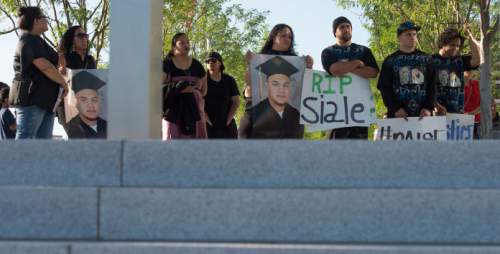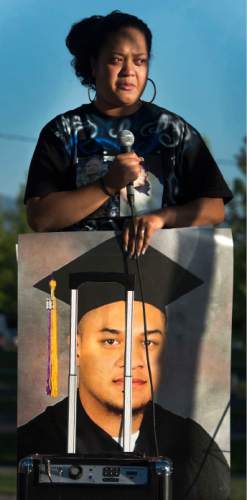This is an archived article that was published on sltrib.com in 2015, and information in the article may be outdated. It is provided only for personal research purposes and may not be reprinted.
Video from the federal courtroom where a marshal shot and killed a gang defendant last year shows the marshal continuing to shoot the man as he fell into the witness box, a lawyer for the man's family said Wednesday.
The footage, taken from the rear of the courtroom, shows Siale Angilau picking up something at the defense table — witnesses have said it was a pen or pencil — then charging toward the witness, said Bob Sykes, an attorney for Angilau's parents.
As Angilau, 25, was going over the top of the witness box, the marshal fired at point-blank range, Sykes said. The marshal continued firing as Angilau was on the floor in the witness box.
"It looks like he was down in the witness box and was finished off in the witness box," Sykes said. "You see his head come up for a minute and then come back down."
In all, the marshal fired four shots in rapid succession, Sykes said. The witness who had been testifying ran to his left out of the box as Angilau was going over the divider. He was not injured.
Sykes said the episode started and finished within seconds, and there was no verbal warning from courtroom security or an effort to subdue Angilau with less-lethal force such as a Taser or baton.
Angilau "was basically shot in the back multiple times," Sykes said. "I just don't see a necessity for that here."
The Salt Lake City-based spokesmen for the U.S. Marshals Service and the FBI, which investigated the shooting, did not return calls seeking comment Wednesday.
Sykes said his clients are deciding whether to proceed with a civil lawsuit against the federal government. The Angilaus cried Monday as they watched the video, Sykes said.
"They were grief stricken," he said.
Angilau's mother and father, Sykes and his daughter and law partner, Rachel Sykes, viewed the video Monday in a room at the same courthouse in Salt Lake City where Angilau was shot.
It is the first time anyone outside of the courts or law enforcement has been allowed to see the video.
Both the U.S. District Court for Utah and the U.S. Marshals Service, citing security agreements with each other that existed before the shooting, have denied requests from The Salt Lake Tribune and other organizations to see it.
The U.S. Marshals Service also has denied requests to disclose written reports related to the shooting.
Sykes said he sent a request to the court in the fall asking to see the video. The request was denied, but Sykes said the court reversed its stance after the American Civil Liberties Union advocated on behalf of the Angilau family.
Angilau had been identified by federal prosecutors as a member of the Tongan Crip Gang and was indicted on racketeering charges in May 2010.
Angilau's trial was the first at the new federal courthouse in downtown Salt Lake City.
On April 21, 2014, the first day of trial, Vaiola Mataele Tenifa was testifying about how Tongan Crip members enter the gang.
The pertinent portion of the video begins at 9:23 a.m., when Tenifa is on the witness stand and Angilau is seated next to his attorney at the defense table. Sykes says the video shows Angilau, who was not wearing shackles, calmly standing up, walking around his attorney and picking up something from the table.
Then Angilau ran forward, Sykes said.
As Angilau, whose autopsy report listed him as 6 feet 2 inches tall and 253 pounds, reached the witness box, one of his arms was above his head like someone swinging a hammer, Sykes said.
As the episode begins, the marshal is off screen, apparently near the jury box. When Angilau runs, the marshal enters from the right of the screen and removes his pistol from underneath his blazer, Sykes said. Sykes said he could then see the pistol recoil.
The courtroom's audio and video recordings are apparently made by separate systems, Sykes said, and he and his clients did not watch and listen at the same time. But Sykes said he could hear the quick succession of the gunshots.
The first command was given to Angilau when he was already down in the box, Sykes said. Sykes was unsure whether that command came from the marshal who fired or a second one who rushed to Angilau after the shooting started.
Sykes said some people would view the video and decide the marshal was right to shoot Angilau. But Sykes said he doesn't see how the witness or anyone else was in mortal danger or at risk for serious injury from Angilau.
"It seems to me," he said, "you don't open fire in that context under those conditions."
Angilau died at a hospital hours after he was shot.
Sykes provided a copy of Angilau's autopsy report Wednesday. It says three bullets struck Angilau in the back. A fourth shot entered the left elbow, exited the elbow pit, entered and exited the left bicep and stopped in the left side of Angilau's chest.
On July 14, the Department of Justice announced that the marshal was justified in shooting Angilau. No federal agency has identified the marshal.
Sykes said the court edited the video to place rectangles over the faces of everyone except Angilau. That, combined with the quality and location of the camera, makes the video of "C to a C-plus quality," Sykes said.
A court employee played the video for Sykes and the Angilaus about 25 times, Sykes said, but did not allow the family or attorneys to control the computer to play snippets back and forth or in slow motion. Neither the family nor the attorney was allowed to keep a copy, though Sykes took notes.
Sykes said the court employee who played the video and chief clerk D. Mark Jones, who helped facilitate the viewing, both gave sincere condolences to the Angilau family members, telling them, "I'm sorry for your loss."
Twitter: @natecarlisle







